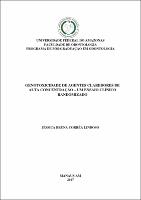| ???jsp.display-item.social.title??? |


|
Please use this identifier to cite or link to this item:
https://tede.ufam.edu.br/handle/tede/6366| ???metadata.dc.type???: | Dissertação |
| Title: | Genotoxicidade de agentes claredores de alta concentração – um ensaio clínico randomizado |
| ???metadata.dc.creator???: | Lindoso, Jéssica Bruna Corrêa  |
| ???metadata.dc.contributor.advisor1???: | Conde, Nikeila Chacon de Oliveira |
| ???metadata.dc.description.resumo???: | O presente estudo avaliou o potencial genotóxico dos agentes clareadores em alta concentração, peróxido de carbamida (PC) 37% e peróxido de hidrogênio (PH) 38%, bem como a influência da barreira gengival fotopolimerizável e seu tempo de polimerização neste potencial genotóxico. Tratou-se de um ensaio clínico randomizado duplo cego onde 56 pacientes foram selecionados e divididos aleatoriamente em dois grupos principais de pesquisa. Foi utilizado o delineamento de boca-dividida em ambos os grupos. No primeiro grupo, o PC37, o agente clareador foi o PC 37%, utilizado na arcada superior com aplicação prévia da barreira gengival fotopolimerizável, formando o subgrupo PCCBG, e em paralelo, na arcada inferior sem a aplicação da barreira gengival, formando o subgrupo PCSBG. No segundo grupo, o PH38, foi utilizado o agente clareador PH 38%, de maneira que na arcada superior a barreira gengival foi aplicada, previamente ao gel clareador, em dois tempos diferentes de polimerização (10 e 30 segundos) gerando, respectivamente, os subgrupos PH10s e PH30s, e ainda, na arcada inferior foi aplicada apenas a barreira gengival, fomando o subgrupo BG. Foram realizadas duas sessões de clareamento dentário em consultório com o intervalo de uma semana entre elas. Coletas de esfregaço da região gengival foram realizadas, a partir da técnica de citologia esfoliativa, no baseline, 14 e 37 dias após o início do tratamento. A genotoxicidade foi aferida a partir do teste de micronúcleos (MN), segundo critérios pré estabelecidos. Os resultados registrados foram submetidos ao teste de normalidade de Shapiro-Wilk e ambos os grupos (PC37 e PH38) apresentaram anormalidade na distribuição dos dados. Analisando os subgrupos como amostras independentes, realizou-se o teste Kruskal-Wallis de igualdade de populações, mostrando que não houve diferença entre eles comparando os três pontos de seguimento (baseline, 14 dias e 37 dias), apresentanto P = 0,8721 no grupo PC37 e P = 0.3548 no grupo PH38. Nenhum dos agentes apresentou potencial genotóxico, assim como a utilização da barreira gengival em diferentes tempos de polimerização não causou aumento na taxa de MN encontrada. Estudos clínicos na exploração desse campo são escassos na literatura, havendo necessidade de mais exploração. |
| Abstract: | The present study evaluated the genotoxic potential of high concentration bleaching agents, 37% carbamide peroxide and 38% hydrogen peroxide, as well as the influence of light-cured gingival barrier and its curing time. It was a randomized double-blind clinical trial where 56 patients were randomly selected and divided into two major research groups. The mouth-split design was used in both groups. In the first group, PC37, the bleaching agent used was 37% carbamide peroxide, applied in the upper arch with prior application of the light-cured gingival barrier, forming the subgroup PCCBG, and in parallel, in the lower arch without the application of the gingival barrier, forming the subgroup PCSBG. In the second group, the PH38, the 38% hydrogen peroxide bleaching agent was used, so that in the upper arch the gingival barrier was applied, prior to the bleaching gel, in two different light-cured times (10 and 30 seconds), generating, respectively, PH10s and PH30s subgroups, and in the lower arch, only the light-cured gingival barrier, forming the BG subgroup. Following this protocol, two in the office bleaching sessions were performed with the interval of one week between them. Swab collections were performed from the gingival region, using the exfoliative cytology technique, at the baseline, 14 and 37 days after the start of treatment. The protocol for treatment and staining of the slides was applied immediately after the collection of the smear and the genotoxicity was assessed from the micronucleus test, according to pre-established criteria. The results were submitted to the Shapiro-Wilk normality test and both groups (PC37 and PH38) presented an abnormality in the data distribution. Analyzing the subgroups as independent samples, the Kruskal-Wallis test of equality of populations was carried out, showing that there was no difference between them comparing the three follow-up points (baseline, 14 days and 37 days), presenting P = 0.8721 in the Group PC37 and P = 0.3548 in the PH38 group. Both agents, hydrogen peroxide and peroxide of carbamide in high concentration, did not present genotoxic potential after two sessions of in office bleaching, as well as the use of the gingival barrier in different times of light-cure did not cause increase in the micronucleus rate found. Further clinical studies in the exploration of this field are necessary, taking into account that bleaching has increased in demand in the office. |
| Keywords: | Clareamento Dentário Teste para Micronúcleos Genotoxicidade |
| ???metadata.dc.subject.cnpq???: | CIENCIAS DA SAUDE: ODONTOLOGIA |
| Language: | por |
| ???metadata.dc.publisher.country???: | Brasil |
| Publisher: | Universidade Federal do Amazonas |
| ???metadata.dc.publisher.initials???: | UFAM |
| ???metadata.dc.publisher.department???: | Faculdade de Odontologia |
| ???metadata.dc.publisher.program???: | Programa de Pós-graduação em Odontologia |
| Citation: | LINDOSO, Jéssica Bruna Corrêa. Genotoxicidade de agentes claredores de alta concentração – um ensaio clínico randomizado. 2017. 78 f. Dissertação (Mestrado em Odontologia) - Universidade Federal do Amazonas, Manaus, 2017. |
| ???metadata.dc.rights???: | Acesso Aberto |
| ???metadata.dc.rights.uri???: | http://creativecommons.org/licenses/by-nc-nd/4.0/ |
| URI: | https://tede.ufam.edu.br/handle/tede/6366 |
| Issue Date: | 7-Apr-2017 |
| Appears in Collections: | Mestrado em Odontologia |
Files in This Item:
| File | Description | Size | Format | |
|---|---|---|---|---|
| Dissertação_Jéssica C. Lindoso.pdf | 1.53 MB | Adobe PDF |  Download/Open Preview |
This item is licensed under a Creative Commons License





